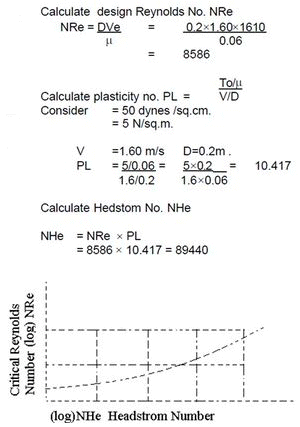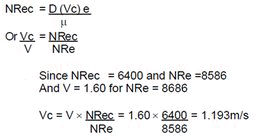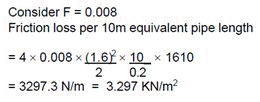 |
Satish Lele lelepiping@gmail.com |
View this page as YouTube Video Presentation
Slurry piping system, like any other system, consists of slurry pumps, pipelines and valves. Special considerations relevant to this systems are introduced by the fact that slurry in not homogeneous phase (unlike gas or liquid). Slurry can be described as liquid with solids suspended therein. Typical industrial instances of slurry handling are:
1 Slope of pipe lines : Slops of horizontal lines should not exceed angle of repose for Slurry.
2 Provisions for flushing and draining of pipe lines and manual cleaning.
3 Selection of wear resistance materials or higher thickness.
4 Identification of wear prone points.
4.1 downstream of weld.
4.2 Joints for easy replacement of worn out positions.
5 Use of long radius bends.
6 No dead spaces.
7 General observation : Wear /erosion is higher for velocities more than 2.1 m/s whereas critical velocity may dictate minimum velocity as 1.2 m/s.
8 Use valves with maximum port size.
8.1 Use full part ball valves.
8.2 Avoid use of globe value (seat may be plugged by solid deposition).
8.3 Provide flushing connections for valves.
Pump for Slurry: Different types as given below can be used.
1 Centrifugal
1.1 For very dilute Slurries, solids concentration up to 10 L), sump type pumps could be used.
1.2 Impeller may have to be replaced frequently due to erosion. Therefore split casing type design is preferred.
1.3 Low efficiencies are to be expected.
1.4 Rubber lining may prove useful in many situations.
1.5 Special wear resistant materials should be used.
1.6 Flushing connection for shaft sealing arrangement is to be provided.
2 Positive displacement (Plunger/piston type)
2.1 Used for high discharge pressure (about 40 bar)
2.2 Plunger type design is preferred for abrasive Slurries.
2.3 Flushing arrangement for plunger packing is desirable.
2.4 Liners of wear resistant materials inside the cylinder can yield longer trouble free services.
Instrumentation: Pressure of solids and possibilities of erosion put many restrictions on instruments to be used. Some relevant observation are as below:
1 For measuring slurry concentration, use of radiation density meters is convenient. However, periodic calibration may be necessary.
2 If a side stream is drawn and then returned conveniently measured by magnetic flow meters (which are rather expensive).
3 Flow rate of slurry can be conveniently measured by magnetic flow meters (which are rather expensive).
4 When positive displacement pump is used for slurry transfer pump speed and displacement can be used to calculate slurry flow rate.
5 Pressure gauges and other instruments mounted on pipe line are susceptible to damage due to vibrations.
6 For measurement of pressure, diaphragm type gauges are recommended these should be provided with back flushing arrangements, connected to pipe line with capillary. Moreover the gauges should be separately supported and not mounted directly on pipe line.
- Coal particals suspended in water (in coal washeries)
- Crystals suspended in solvent in crystallization (wax manufacturing process)
- Feed to any filtration equipment
- Pulp suspension encountered in papermaking, sludge encountered in effluent treatment
One or more of various considerations such as solid concentration determines behavior of slurry.
- Usually expressed in wt. % of solid
- Practical size of solids nature of solids (soft, hard, abrasive)
- Properties of liquid (density, viscosity, chemical nature)
- No solid deposition in system.
- No change in slurry composition from inlet to outlet of the system.
- Minimum wear and tare or erosion.
- Line sizing and pressure drop.
- Special consideration
- Pumps for slurry.
- Instrumentation.
- Identify slurry characteristic: Slurries can be classified into broad categories as homogenous or heterogeneous. The type of slurry (Whether homogeneous or heterogeneous) dictates rheological properties and there fore characterization is important.
Homogeneous Slurry: In this type of slurry, solid particles are uniformly distributed in liquid medium. Such slurries are characterized by high concentration of solids having small (fine) particle size. Typical examples are sewage sludge, clay slurry.
Cement kiln feed slurry: Such slurries usually exhibit non-Newtonian flow behavior (effective viscosity changing with shear rate). Majority of them show behavior like Bingham plastic (no shear rate up to yield stress and Newtonian behavior for stress beyond yield stress).
Heterogeneous Slurry: The solids are not uniformly distributed in liquid in such Slurries. In a horizontal pipe the concentration of solids is higher at lower levels and lower at upper levels. Such a Slurry is characterized by low concentration of large size particles. Phosphate rock Slurry is typical example of this type.
Mixed behavior of Slurry: Many Slurries encountered in industry may show behavior in between homogeneous and heterogeneous. This would be more so when particles of different sizes constitute the Slurry. In such a situation dominant characteristics have to be identified and design procedure adopted to arrive at safer design. A typical example of this type is Slurry of coal particles in water. - Select slurry concentration: Solid concentration of Slurry becomes an important consideration for following reasons:
Solids concentration governs the Slurry specific gravity (and hence pumping cost) and sometimes the rheoloy of the Slurry. At certain solid concentration Slurry may be difficult to transport or unstable. In such situations solids concentration would have to be selected for proper transportation. Solids concentration in static settled Slurry would be a useful guidance in this respect. Generally solid concentration 10-15% below static settled Slurry concentration would prove stable and convenient for handling.
Solid concentrations in settled Slurries could depending on nature of solid, vary over a wide range (10-50%) Generally solids with particle size of 0.4-0.5 micron may form a stable Slurry for solid concentration up to 40%. - Select trial pipe size: Since the throughout of Slurry (volume /time) is known selection of pipe size (particularly pipe Inside dia) will determine the velocity of Slurry through the pipe.
vol. flow rate = velocity ×area of cross section.
The velocity calculated is referred to as design velocity. The design velocity is significant with reference to the critical velocity. Critical velocity is an important parameter for a Slurry. When Slurry flows at velocity below the critical velocity solids in slurry may start separating out and setting in a horizontal pipe. The critical velocity is analogous to transition velocity in flow of homogeneous fluids, the velocity at which laminar flow ceases to exist (Reynolds No. = 2100).
Tendency of solids in Slurry to settle or separate out will be reduced in pressure of turbulence. The critical velocity for a given Slurry will be determined by different parameters such as size and specific gravity of solids, solids concentration viscosity of liquid and degree of turbulance. - Calculate critical velocity: Calculations of critical velocity for homogeneous Slurry is now described as below. For heterogeneous Slurries the procedure is little complex. For homogeneous Slurry, the procedure for calculating critical velocity is as follows:
A) If the Slurry shown Newtonian behavior, then critical Reynolds’s No. is considered as 2100 and critical velocity is calculated.
Slurry Flow Rate = 3,000 liters / minute = 3 cu.m. / minute
Apparent Viscocity of Slurry = 60 cp (centi Poise) = 0.06 poise
Specific Gravity of Slurry = 1.61
Density = 1,610 Kgs / cu. m.
for Reynold's Number of 2,100, assume Pipe ID = 200 mm = 0.2 meter
Reynolds Number x Viscosity
Velocity = -------------------------------
Density x Pipe Dia
2100 x 0.06
Velocity = -------------- = 0.39 meters / sec
1610 x 0.2
The velocity, you select should be greater than this critical velocity.
B) If the Slurry is non-Newtonian type and exhibits Bingham plastics type behavior, then the procedure adopted for calculating critical velocity is as follow:

Enter the chart with value of NHe, find the value critical Reynolds No. NRec. In present case NRec = 6400 (say). Calculate critical velocity (Vc). Critical velocity can be calculated by using one of the following relationships:

- Compare design velocity with critical velocity:
Vc = 1.193 m/s.
V = 1.60 m/s.
V-Vc = 1.6-1.193 = 0.417 m/s.
The trial pipe size selected should be such that (V-Ve) should be 0.3 m/s or more. In the calculations above (V-Vc) = 0.417 m/s, therefore selected pipe size is satisfactory. - Calculate design friction loss: Once the selected trial pipe size is satisfactory, the pressure loss can be calculated by usual equation:

For this calculation, the numerical value of f is to be selected from f Vs NRe charts. Since f depends on roughness of pipe, as a considered (Hazen William factor = 100). Secondly , it is a common practice to express the friction loss per say 10m of piping. For this purpose equivalent lengths of fittings etc. Have to be taken into account.

Since Slurry sp. gr. is 1.61

- Calculate system pressure gradient and pump discharge pressure:
For transport of such a Slurry consider elevation change = 10m
And total equivalent length =200m
Total head to be developed by pump

Pump discharge pressure required (for flooded suction condition)

1 Slope of pipe lines : Slops of horizontal lines should not exceed angle of repose for Slurry.
2 Provisions for flushing and draining of pipe lines and manual cleaning.
3 Selection of wear resistance materials or higher thickness.
4 Identification of wear prone points.
4.1 downstream of weld.
4.2 Joints for easy replacement of worn out positions.
5 Use of long radius bends.
6 No dead spaces.
7 General observation : Wear /erosion is higher for velocities more than 2.1 m/s whereas critical velocity may dictate minimum velocity as 1.2 m/s.
8 Use valves with maximum port size.
8.1 Use full part ball valves.
8.2 Avoid use of globe value (seat may be plugged by solid deposition).
8.3 Provide flushing connections for valves.
Pump for Slurry: Different types as given below can be used.
1 Centrifugal
1.1 For very dilute Slurries, solids concentration up to 10 L), sump type pumps could be used.
1.2 Impeller may have to be replaced frequently due to erosion. Therefore split casing type design is preferred.
1.3 Low efficiencies are to be expected.
1.4 Rubber lining may prove useful in many situations.
1.5 Special wear resistant materials should be used.
1.6 Flushing connection for shaft sealing arrangement is to be provided.
2 Positive displacement (Plunger/piston type)
2.1 Used for high discharge pressure (about 40 bar)
2.2 Plunger type design is preferred for abrasive Slurries.
2.3 Flushing arrangement for plunger packing is desirable.
2.4 Liners of wear resistant materials inside the cylinder can yield longer trouble free services.
Instrumentation: Pressure of solids and possibilities of erosion put many restrictions on instruments to be used. Some relevant observation are as below:
1 For measuring slurry concentration, use of radiation density meters is convenient. However, periodic calibration may be necessary.
2 If a side stream is drawn and then returned conveniently measured by magnetic flow meters (which are rather expensive).
3 Flow rate of slurry can be conveniently measured by magnetic flow meters (which are rather expensive).
4 When positive displacement pump is used for slurry transfer pump speed and displacement can be used to calculate slurry flow rate.
5 Pressure gauges and other instruments mounted on pipe line are susceptible to damage due to vibrations.
6 For measurement of pressure, diaphragm type gauges are recommended these should be provided with back flushing arrangements, connected to pipe line with capillary. Moreover the gauges should be separately supported and not mounted directly on pipe line.
 to get all the information as a eBook
to get all the information as a eBook
